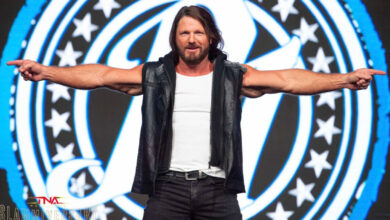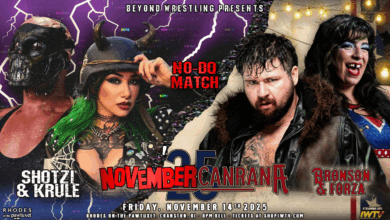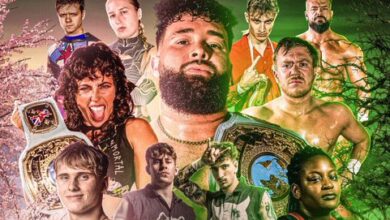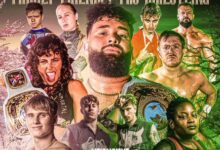Outside His Element: Steve Austin takes his old formula on his new journey
“Hopefully people enjoy me being Steve.” It’s the reverse of Diddy’s closing line on his “Victory” verse: Stone Cold, known for telling it like it is, is giving way to Steve Austin, who’s wondering just what things might be. For someone known for taking risks, from remixing the world’s most enduring Bible verse, to hitting his hospitalized boss over the head with a bedpan, post-wrestling Steve Austin is playing his music with the volume at 5. His latest endeavor, the A&E reality series “Stone Cold Takes on America”, is less of a fight and more of a conversation. He’s bowling with the elderly. He’s hunting ghosts. He’s asking if you want fries with that. But more than anything, he’s showing what made his first career work so well: the chemistry he’s been able to produce with just about anyone continues to make him good in any room.
When you call someone a natural, you have to be careful not to undermine the work, and sacrifice they put into their craft. Steve Austin had the speed, the timing, the sheer will to stand out in an ecosystem run by the Rick Rudes, the Ricky Steamboats, and the Ric Flairs of the world. But the experience of having to survive and thrive at once is why Austin always found a way to make it work, no matter the scene. “… when I started in Dallas, Texas, I was still driving a forklift. And then two months later, after [I started] getting a crap beat out of me, they shipped me to Tennessee to start working. And you got on that circuit, and when you’re making $15 and $20 a night and you’re driving 400 miles round trip and you literally are starving, you better learn how to draw money, because if you’re not really drawing money, you ain’t going to make it. So your life depends on it. So you look to have chemistry with anybody, and how do you make things work? How do you make all the things connect?” Steamboat would be the first static connection of Austin’s career.
Probably his most comfortable outing on “Takes On” has Austin go from Miller Lite center fielder to starting pitcher, putting him behind the bar to make and serve drinks. The bartenders at Fuel Bar give him a crash course in his new role, from shaker juggling techniques to making sure he actually collects the money for the drinks. There’s a talent in taking someone so new to a task, and making sure they shine right away. Going into Spring Stampede 1994, Austin and Steamboat would compete for a shot at Ric Flair’s World Heavyweight championship on WCW Saturday Night. Austin, flanked by a civilian Robert Parker, went into the match as US Heavyweight champion. Prior to neck and knee injuries, Austin could run, flip and leapfrog with the best of them, and Steamboat was the very best. When describing Steamboat, Austin doesn’t immediately go to the athleticism, but the understanding, the familiarity that still resonates with him. “It’s just you for some reason, they’re on the same page as you in an opposite fashion, because if you’re doing this, they have to do the other part of that gear. And working with Steamboat, man, if I grabbed a headlock on Steamboat.. I would work the headlock, but he’d top wrist out of it. I didn’t have to tell him to do that. He would just do that. Steamboat would do steamboat stuff.” The Steamboat stuff in question is this amazing feeling out process. It’s reversal after reversal, and the emotion on both their faces of not wanting to lose A HOLD, let alone a match to the other guy, is evident. Austin, at this point being his “Stunning” persona, was so hell-bent on showing up the white meat babyface Steamboat, he’d tap his own head with his pointer finger, while trapped in a headlock, to show how smart he was before reversing the hold. It’s this disrespect of the old guard that isn’t actually threatened that made what was an athletic feud a deeply personal one. Bobby Heenan, just before they start to go for more impact off the ropes, acknowledges that “they’re both laying back” so as not to give the other an advantage. Austin immediately reverses a running cross body block into a pinning attempt, followed by absolute urgency between the two, with actual blows not coming until 5 minutes into the match. Ultimately, Steamboat won the match by disqualification due to interference, and while the focus transitioned to Steamboat and Flair, a very young Austin went 15 minutes with no break, no wasted motion with possibly the best in-ring wrestler of that era, off of non-verbal communication and sheer effort.
There’s probably no greater example of chemistry with a contemporary than Steve Austin’s sprawling, dedicated feud with Dwayne “The Rock” Johnson. It was a bit of a role reversal- whereas a young Austin had guys like Steamboat to teach him the craft, Rock was basically in his first year of wrestling when he and Austin first locked horns. One of the toughest jobs Austin picks up in the series is that of a drive through worker at a fast food restaurant, and his approach is one that both a new hire and a district manager would appreciate. “… on one hand, I could have went in there and played it up for the humor. Someone was taking an order and said, ‘a cheeseburger’ [and I could reply] ‘what, a cheeseburger?’ I mean, I could have done that, but I was just trying to do a job to a satisfaction level that would be worthy of a good employee trying to learn the system. And so maybe I missed a few moments there with that, but that was in that process of where I was trying to find myself and like, ‘hey, man, what is the show?’ When I’m doing these fish out of water moments, I was nervous trying to work that thing and hit all the controls, and luckily they had that guy that was helping me out. ” Austin and Rock’s rivalry, probably the most popular and lucrative in-ring feud ever, spanned roughly 5 years and 3 Wrestlemanias. They’d initially cross paths over the Intercontinental Championship, where we’d see a rookie Rock try his damndest to one up the red hot Austin, and ultimately finesse the title away from him.
Financially, the feud’s zenith was Wrestlemania 17, where Austin would defeat The Rock with the assistance of sworn enemy Vince Mcmahon. Artistically, Wrestlemania 19 may be them at their most confident and comfortable with one another. In what would be Austin’s final match for 19 years, he’d lost after three Rock Bottoms to a reinvigorated, brash, hyperbolic Hollywood Rock. But it’s an earlier match, where both were still on their way to proving themselves that would really showcase just how well they worked together. The March 23rd, 1998 episode of Monday Night Raw was the final show before Wrestlemania 14. Steve Austin was 6 days away from producing the flashpoint of the attitude era, defeating Shawn Michaels for the then-WWF Championship with a Stone Cold Stunned and pinfall counted by Iron Mike Tyson. The Rock was headed into his toughest title match since originally securing the title from Austin, facing UFC legend Ken Shamrock. As both a favor to Degeneration X and a punishment to Austin, Vince Mcmahon scheduled Austin to go one on one with the future Great One as his final test before Wrestlemania. Rock, flanked by his revamped Nation of Domination [having excommunicated Faarooq] was still building toward his “Most Electrifying” persona. At just 26, Rock had only been in WWE 16 months. But new as he was, his charisma and athleticism, matched with Austin’s timing and experience, gave glimpses to what would carry WWE through its most successful period to date.
“The hunger that he had and the passion that I had. I mean, when we got together, I brought out the best in him and he brought out the best in me. And it was both about two cats being… trying to be number one, but not trying to be number one by one-upping each other, but by working together to make each other the biggest and best.” There’s a level of showmanship in their lockups throughout the match that give you glimpses to what the finished product would be. Rock begins by backing Austin into the corner, and as Austin reverses Rock into the same spot, he backs off, giving Rock the double salute. As he walks off, it’s Rock staring him down, then looking off into the crowd, irate at the disrespect. When Rock finally gains an advantage off of a shoulder block, he attempts to show Austin up with a middle finger, and is greeted with a punch to the face. The match itself is heavy on Irish whips, on clotheslines, on swinging at each other hard as possible. There’s so little air between them most of the match, it’s physical without being visceral, it’s fast without being exhausting. Rock counters a stunner and immediately slides out the ring to regroup with The Nation, ripping the momentum from Austin and denying the crowd the move they all paid to see. There’s no audible crowd acknowledgement of his recently debuted People’s Elbow (he doesn’t even remove his elbow pad) outside of the actual strike. Austin ultimately rallies in the face of Nation distractions and interference to beat the Rock clean with a stunner, with only a slight Rock flail on impact. Over time, we’d see them become the two biggest stars in the business. The insults would get more personal, the reactions more outlandish, and the stunners would see a lot more torque. But it’s that desire to push one another, to have a contemporary to keep you fresh and enduring, that made the two work so well together.
Austin credits his ability to be good just about anywhere to upbringing and early surroundings. At one point, he accompanies a team of Ghost Hunters on a phantom finding mission, and does his best to keep the very serious surveillance light. The woman leading the team suggests the experience might help him open his third eye, to which he replies that all the chair shots he’s taken will likely keep that third eye closed going forward. No matter the endeavor, no matter the perceived prestige of the task, Steve Austin will do all he can to make it work. “My mom and dad taught us to always work hard, keep your head down and don’t get the big head. So I never lost sight of that. And I enjoy being around people. I love to BS people. I can make them laugh. I’m not a stand up comedian, but I can make a light hearted situation out of just about anything, and my glass is always half full.” There’s probably nothing more lighthearted about his time in professional wrestling than his WCW/ECW Alliance skits with Olympic hero turned WWE legend Kurt Angle. Austin, at this point desperate for the professional affections of Vince McMahon, was at his most paranoid, fearing that one of the other main eventers, be it Rock, Booker T, or Angle himself would occupy space in Vince’s heart reserved for him. This desperation, coupled with Angle’s willingness to show ass on a comedic level, resulted in some of the very best backstage content ever produced. “… Kurt is so talented. He would just go back and forth with me. And he had that hokeyness about him along with that shoot aspect of being in a 96 at the gold medalist. He was one of those shoot guys that had the ability to drop the ego out of it and just play upon his strengths, which was sometimes being aloof or just saying stuff. He has great comedic timing. He’s very articulate, very eloquent. He can memorize anything at the drop of a hat.” They’d dress up, they’d dress one another down, they’d do everything they could to male the other pop. Probably their finest BS job during that run was on an edition of Smackdown when the Alliance first started to crack McMahon’s confidence. Austin, then WWF champion and still firmly on the side of the boss, would fix Vince’s issues the best way he knew how: through guitar and song. He’d play a medley of hits, most notably “Camptown Ladies” in his throaty tenor. Vince, on the verge of a migraine, was relieved to see Kurt come in. Austin immediately glares at Kurt, and accuses him of being jealous of their relationship. You can see Austin on the verge of cracking, as Kurt lists off his glee club accomplishments, and slides close to Kurt on the couch as he begins to play “Jimmy Crack Corn”. The two were so good together, they’d normally only take one practice run to nail the skit. “Only one time when I was singing to him on that guitar, I actually busted and we broke the tank and busted character and we had to redo that one. But most of those done, you can ask Kurt. Most of those were one, two take deals at the most. Most of them were one take deals where I’d come up with these ideas and it was just an ad lib… And so I just think it speaks to our skills of just being able to do what we did and then putting those two skills together and feeding off of each other and trusting each other and just letting it fly.”
Every chemical reaction can’t produce gold. While he was Bionic in the ring, Steve Austin doesn’t take issue accepting his humanity. A consummate outdoorsman, Austin is at one point in the series challenged to drive a dune buggy up a sand mountain. “I know I can do it,” he says, while taking a second to gather himself, “I just don’t know how well I can do it.” He acknowledges that the run won’t be successful, and he pulls up short. While it seems like the most natural fit, something just doesn’t seem to be clicking. For someone so used to making the room their own, what happens when it’s already decorated? Of all the fantastic matches and moments, there’s one opponent Austin wishes he’d been more in tune with. “I think Undertaker and I had a hard time really connecting in the ring. I thought our gimmicks were so similar. [He was] The Phenom. I was Stone Cold. But [I had] black gear. Taker was wearing black gear. Two tough guys. When Taker was a baby face, he wasn’t a sympathy baby face, he was a respect baby face. When Stone Cold was a baby face, I wasn’t a sympathy baby face, I was a respect baby face. And you expected me to kick ass.” With Steamboat, there was a certain juxtaposition of approach, a teacher/student relationship, and Austin needing to try to outclass the more experienced party. The Rock was still figuring out how to be The Rock, so as time went on, they understood what the other needed to shine. And with Angle Austin was allowed to tap into something we’d seen very little of with someone able to add exclamation points to the jokes. With the Undertaker, there was so little give on each side, not out of selfishness, but just so much sameness making it hard to reach another level.
Their most notable matchup was Summerslam 1998, with Undertaker challenging Austin for the WWF title. The crowd is respectfully cheering for both, with the Undertaker dominating early. In a move that would inspire a thousand tweets, Taker very early in the match hits him with his former “Stunning” finisher, the Hotshot. It’s not a bad match by any standard, it’s just two acts doing a lot of the same thing, seemingly splitting not only the crowd, but the reaction as well. Austin, admittedly concussed during the match, had high expectations that didn’t come to fruition. “As much as I sold for him or he sold for me, the fact that there were just these two guys of the DNA that they were made of, for some reason, I thought. And Mark and I had some good matches. I got knocked out in the Madison Square Garden match, which we were going to be on our way to a damn good match on that one. And I got knocked out and don’t remember the rest of it, but we had a hard time connecting.” Things picked up when Kane made an appearance, teasing interference on behalf of Taker. Even with its shortcomings, there were things done to accentuate what was presented. Even with the failure to conquer the dune, Austin took the advice of the expert driver, most notably that he wasn’t being sure handed with the steering wheel. Austin sold for Taker’s power moves outside of the ring, most notably a bearhug into the ring post, and a top rope leg drop from the top rope to the announce table. The resilient Austin would survive a chokeslam, and secure the win reversing Taker’s Old School with a low blow and a Stunner. And to preserve the Deadman’s honor, he’d hand the title to Austin and give him a nod in acknowledgement. Even when it “didn’t work”, the proper emotion, the proper reaction came through for Austin more times than it did not.
Being the avatar for the talented, yet disgruntled worker, being the guy literally sharing a beer with you every week, carried Stone Cold Austin to unprecedented success in the world of wrestling. Now, Steve Austin’s looking to reclaim some of that time. He possesses an almost photographic memory of his times as the Toughest SOB, but wants that ability to resonate, to connect with the people, to carry over to his new path. “And it took me a while… to kind of find who and what I was in this show because it was a little bit of an identity complex… I’m not being Stone Cold and I’m a different guy. I live in a small town in Nevada, and [my friends and I] don’t talk about what I used to do. We talk about the here and now. So I don’t relive those days and I don’t walk in there and say, ‘hey, if I’m going to drink a Broken Skull IPA, give me a hell yeah!, I go in there very quietly and go get my beer and sit down and shoot the breeze with my buddy.” Austin may be using a new lab, but the formula he’s concocted by both owning the room and welcoming everyone into it continues to help him win.




